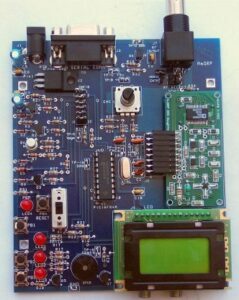 The AmQRP “PIC-EL Kit” is a multi-function PIC16F84A-based project board designed by Craig Johnson, AA0ZZ and the American QRP Club for experiments being conducted by John McDonough, WB8RCR in his online PIC Elmer 160 course. The course material is geared around use of common I/O components — pushbuttons, LEDs, LCD display, rotary encoder and speaker — and experiments are designed to take the student through a step-by-step creation of software programs that beep, display and otherwise interact with the user.
The AmQRP “PIC-EL Kit” is a multi-function PIC16F84A-based project board designed by Craig Johnson, AA0ZZ and the American QRP Club for experiments being conducted by John McDonough, WB8RCR in his online PIC Elmer 160 course. The course material is geared around use of common I/O components — pushbuttons, LEDs, LCD display, rotary encoder and speaker — and experiments are designed to take the student through a step-by-step creation of software programs that beep, display and otherwise interact with the user.
The PIC-EL board optionally uses the popular NJQRP DDS Daughtercard to generate RF frequencies up to 30 MHz. Several course lessons will be structured to guide the student through the process of controlling the DDS chip with the PIC microcontroller.
The “Pickle” board also has a built-in serial programmer that allows you to download new programs directly from the PC and “burn” them into the PIC microcontroller … without requiring any other specialized programming hardware!
The PIC16F84A included in the kit is pre-programmed with a special test program that exercises the circuit components (LCD, LEDs, encoder, pushbuttons, etc.) so you can see the Pickle board work right away.
A software program called FPP allows you to program the onboard PIC from your PC is available from the project web page. Just connect the PC to your Pickle board using a standard 9-pin serial cable and you can “burn” new programs into the PIC. (Instructions on downloading and setting up the FPP program on your PC are provided in a separate lesson document EL160L10.PDF, also available on the project web page.)
The PIC-EL Kit is easy to assemble. You can use the schematic, parts list and photos included on this Quick Assembly Guide to assemble the board.
Once you have built the PIC-EL project board and followed along in the Elmer 160 course, the fun doesn’t stop! You will be able to use your Pickle board for many projects on the bench and in the workshop for years to come. It can serve as a multi-function standalone VFO, a memory keyer and other projects as contributed by the many PIC-EL owners.
